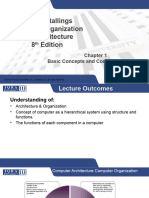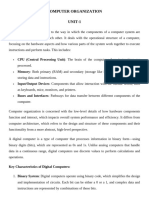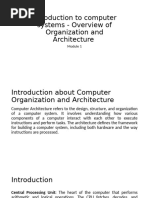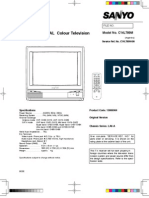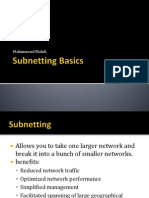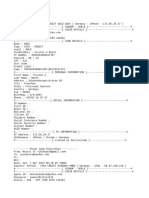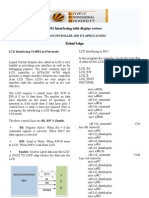0 ratings0% found this document useful (0 votes)
1 viewsAnswer
Computer architecture is the design and organization of a computer's components and systems, including the CPU, memory, I/O devices, and bus systems. It encompasses various architectures like Von Neumann and Harvard, and includes performance factors such as clock speed and cache memory. Modern trends in computer architecture focus on parallel computing, quantum computing, and energy efficiency to enhance system performance and reliability.
Uploaded by
Mohammed EzzatCopyright
© © All Rights Reserved
Available Formats
Download as DOCX, PDF, TXT or read online on Scribd
0 ratings0% found this document useful (0 votes)
1 viewsAnswer
Computer architecture is the design and organization of a computer's components and systems, including the CPU, memory, I/O devices, and bus systems. It encompasses various architectures like Von Neumann and Harvard, and includes performance factors such as clock speed and cache memory. Modern trends in computer architecture focus on parallel computing, quantum computing, and energy efficiency to enhance system performance and reliability.
Uploaded by
Mohammed EzzatCopyright
© © All Rights Reserved
Available Formats
Download as DOCX, PDF, TXT or read online on Scribd
You are on page 1/ 2
Powered by AI
Copilot
Computer architecture is a fundamental concept in computer
science and engineering that involves the design and organization of
a computer's components and systems. Here's a detailed
breakdown:
**1. Definition**
Computer architecture refers to the structure and behavior of a
computer system as seen by the user. It encompasses the design of
the hardware, the system's operational principles, and the
interaction between hardware and software12.
**2. Key Components**
● Central Processing Unit (CPU): The brain of the computer,
responsible for executing instructions.
● Memory: Includes both primary memory (RAM) and secondary
storage (hard drives, SSDs).
● Input/Output (I/O) Devices: Interfaces for user interaction
and data exchange, such as keyboards, mice, and printers.
● Bus Systems: Communication pathways that transfer data
between components.
**3. Types of Computer Architecture**
● Von Neumann Architecture: The most common
architecture, where the CPU, memory, and I/O devices share a
single communication pathway or bus.
● Harvard Architecture: Separates the storage and signal
pathways for instructions and data, allowing simultaneous
access to both.
● Microarchitecture: The detailed design and organization of a
processor's internal components.
**4. Instruction Set Architecture (ISA)**
ISA is a critical part of computer architecture that defines the set of
instructions a processor can execute. It acts as an interface between
software and hardware, specifying the machine language
instructions that a computer can understand 3.
**5. Performance Factors**
● Clock Speed: The speed at which a CPU executes instructions,
measured in GHz.
● Cores: Multiple processing units within a single CPU, allowing
parallel processing.
● Cache Memory: Small, fast memory located close to the CPU
to speed up access to frequently used data.
Powered by AI
● Pipelining: Technique where multiple instruction phases are
overlapped to improve performance.
**6. Balancing Factors**
Computer architecture aims to balance performance, efficiency,
cost, and reliability. Designers must consider trade-offs between
these factors to optimize the overall system4.
**7. Modern Trends**
● Parallel Computing: Using multiple processors or cores to
perform computations simultaneously.
● Quantum Computing: An emerging field that leverages
quantum mechanics to perform complex calculations much
faster than classical computers.
● Energy Efficiency: Designing systems that consume less
power, crucial for mobile and embedded devices.
Understanding computer architecture is essential for designing
efficient, powerful, and reliable computer systems. It bridges the
gap between hardware and software, ensuring that both work
together seamlessly to perform complex tasks.
If you have any specific questions or need further details on any
aspect, feel free to ask!
Source(s)
1. Computer Architecture: Components, Types and Examples - Spiceworks
2. What is computer architecture? - University of Sunderland
3. What is Computer Architecture? - Definition from Techopedia
4. Computer architecture - Wikipedia
You might also like
- Lecture 1 Introduction To Computer Architecture and OrganizationNo ratings yetLecture 1 Introduction To Computer Architecture and Organization69 pages
- 1- Introduction to Computer ArchitectureNo ratings yet1- Introduction to Computer Architecture9 pages
- Computer Architecture and Computer OrganizationNo ratings yetComputer Architecture and Computer Organization16 pages
- Architecture of Computers: Vistula UniversityNo ratings yetArchitecture of Computers: Vistula University34 pages
- Fundamentals of Computer Assignment ReportNo ratings yetFundamentals of Computer Assignment Report27 pages
- Module 1. Introduction.. Overview of Computer Organization and ArchitectureNo ratings yetModule 1. Introduction.. Overview of Computer Organization and Architecture58 pages
- Chapter 1 - Introduction To Computer Architecture and OrganizationNo ratings yetChapter 1 - Introduction To Computer Architecture and Organization21 pages
- Computer Architecture and Organization: Adigrat University Electrical and Computer Engineering Dep'tNo ratings yetComputer Architecture and Organization: Adigrat University Electrical and Computer Engineering Dep't35 pages
- Cs1304-Computer Architecture Department of Cse & ItNo ratings yetCs1304-Computer Architecture Department of Cse & It105 pages
- 3.1 Computer Architecture & Fetch Execute CyclNo ratings yet3.1 Computer Architecture & Fetch Execute Cycl13 pages
- Fundamentals of Modern Computer Architecture: From Logic Gates to Parallel ProcessingFrom EverandFundamentals of Modern Computer Architecture: From Logic Gates to Parallel ProcessingNo ratings yet
- Embedded-and-Real-Time-Systems-2 Marks FinalNo ratings yetEmbedded-and-Real-Time-Systems-2 Marks Final20 pages
- Computer Science: Learn about Algorithms, Cybersecurity, Databases, Operating Systems, and Web DesignFrom EverandComputer Science: Learn about Algorithms, Cybersecurity, Databases, Operating Systems, and Web DesignNo ratings yet
- Get .CRX Chrome Extension File, It's Source Code and Download .CRX To Your ComputerNo ratings yetGet .CRX Chrome Extension File, It's Source Code and Download .CRX To Your Computer5 pages
- Remote, Permanently-Installed Wall Thickness Monitoring.: Up To 32 Daisy-Chained Transmitters Per Cable DropNo ratings yetRemote, Permanently-Installed Wall Thickness Monitoring.: Up To 32 Daisy-Chained Transmitters Per Cable Drop2 pages
- Higher National Computing Tutor Resource Pack Second Edition Core Units For BTEC Higher Nationals in Computing and IT Howard Anderson100% (4)Higher National Computing Tutor Resource Pack Second Edition Core Units For BTEC Higher Nationals in Computing and IT Howard Anderson84 pages
- Chassis LA6-A LA6A Mono Manual de ServicioNo ratings yetChassis LA6-A LA6A Mono Manual de Servicio26 pages
- Acer JV50-TR - 09230-1 - 0616 RSB Schematic (Bioshunger)No ratings yetAcer JV50-TR - 09230-1 - 0616 RSB Schematic (Bioshunger)61 pages
- Tutorial On File Organization: Comparison of File OrganizationsNo ratings yetTutorial On File Organization: Comparison of File Organizations15 pages
- Fundamentals of Lans: "Do I Know This Already?" QuizNo ratings yetFundamentals of Lans: "Do I Know This Already?" Quiz4 pages
- KSS 85 Configuration of Kinematic Systems enNo ratings yetKSS 85 Configuration of Kinematic Systems en123 pages
- International Journal of Electronics and Communications (AEÜ)No ratings yetInternational Journal of Electronics and Communications (AEÜ)5 pages
- Sun Ray Server Software 4.2 Installation and Configuration Guide For SolarisNo ratings yetSun Ray Server Software 4.2 Installation and Configuration Guide For Solaris66 pages
- Power Semiconductor Devices - Abbreviations - SymbolsNo ratings yetPower Semiconductor Devices - Abbreviations - Symbols4 pages
- Commisioning Files - Mini DVM S ECO Heat Pump PDFNo ratings yetCommisioning Files - Mini DVM S ECO Heat Pump PDF10 pages
- List of Accredited Software and - or Hardware (CRM - POS) As of 06-Sep-2018No ratings yetList of Accredited Software and - or Hardware (CRM - POS) As of 06-Sep-2018312 pages
